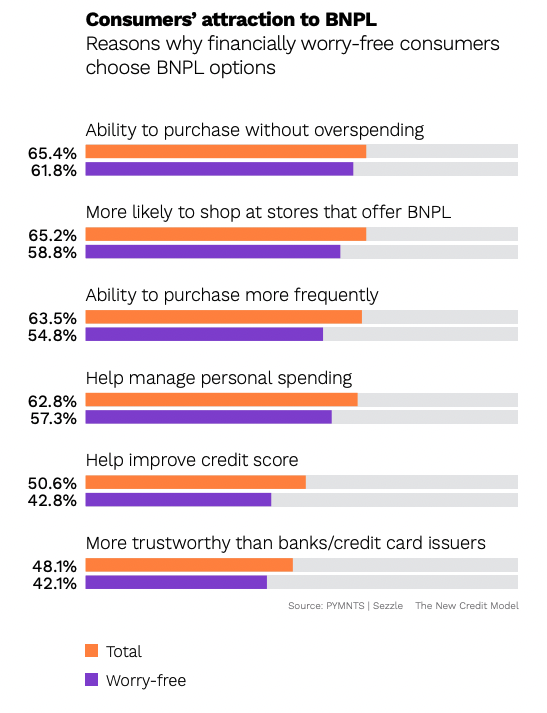
Sift through the filings, listen to the calls with management, and earnings season gives a sense of how consumers — and merchants — are embracing buy now, pay later (BNPL).
The overarching theme? Despite macro headwinds and the ongoing grappling with inflation, several key metrics are healthy.
In the midst of the pandemic, joint research from PYMNTS and Sezzle in the report “The New Credit Model: Why Financially Worry-Free Consumers Still Want Alternatives to Traditional Credit” showed that BNPL held wide appeal among several cohorts of consumers, including those not financially pressured and “worry free” individuals, who cited the value of paying over time and to purchase without overspending.

Fast forward a year and a half, and other, more recent research, this time from PYMNTS and Elan in the report “Credit Card Use During Economic Turbulence” showed that amid the inflationary surge over the past several months (and the fact that debt has become more expensive), a significant number of consumers have ramped spending on credit cards. However, 15% have decreased their spending via credit cards, and that has left room for consumers to find other, alternative means of paying for goods and services.
The earnings reports over the past few months from pure-play BNPL providers and those who have folded BNPL into their ecosystems indicate that the tailwinds for paying in installments remain intact.
Among the most telling indicators of BNPL’s embrace are volumes, variously defined as gross sales volumes or merchant sales volumes. Across the board, those volumes are up, markedly so.
Splitit, for example, disclosed in supplemental materials during its earnings report April 28 that merchant sales volumes surged 34% year on year. PayPal saw volumes swell 70% year on year to $6 billion. Block (Square’s parent), said its BNPL platform generated $5.6 billion in volumes in the first quarter, up 18% year on year. Similarly, Affirm’s growth rate year on year was 18%. Sezzle’s latest business update showed 9% growth for the month of February, measured in underlying merchant sales. Klarna’s earnings results, through December, showed gross merchandise volume (GMV) up 22% year on year.
Affirm’s results and commentary from the conference call give some granular insight into where consumers are using BNPL and where they aren’t. Travel remains a key area of strength, where that category saw volume growth of 62% as consumers leverage BNPL to buy experiences instead of electronics or sporting goods.
Management pointed out that demand for discretionary goods has been “tepid.” The consumer electronics category declined 8% year over year. The home/lifestyle category declined 10% year over year. The sporting goods and outdoors category was down 48% year over year.
For the platforms PayPal and Block, management noted that there’s some cross-pollination in the mix, and ticket sizes grow when BNPL is an option at the point of sale. PayPal management remarked that consumers have been spending 30% more on branded checkout when using BNPL, adding that over 90% of the customers coming in BNPL are already PayPal customers.
Block Chief Financial Officer Amrita Ahuja said that integrating Afterpay with Square and Cash App ecosystems has shown some “encouraging early adoption” as its Discover tab drives increased engagement with BNPL for in-person transactions and online.
“We’re seeing evidence that BNPL is finding wide berth even beyond these aforementioned providers: Amazon Rewards Visa cardmembers are now being offered the option to pay over time,” per emails seen by PYMNTS.
There’s increasing scrutiny on these companies’ path toward profitability. Affirm’s operating loss in the quarter was $310 million, and funding costs will remain elevated, which in turn is expected to pressure margins.
Affirm’s materials showed 19% growth in active merchants to 246,000 year on year. PayPal has said BNPL is available at 3 million merchants since inception. Zip’s merchant count was up 16% to just under 99,000.